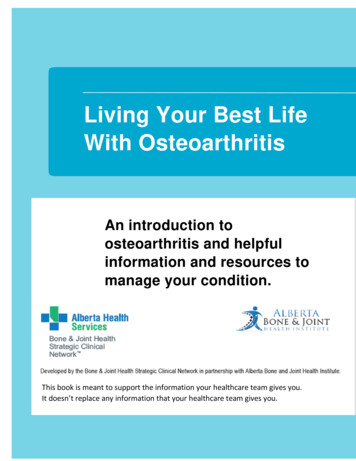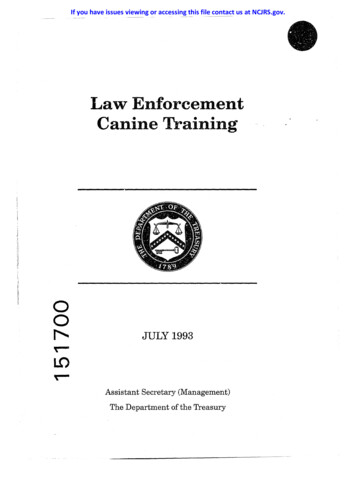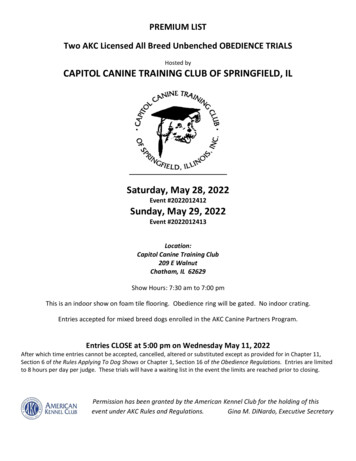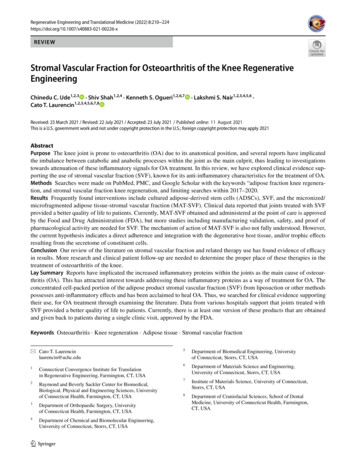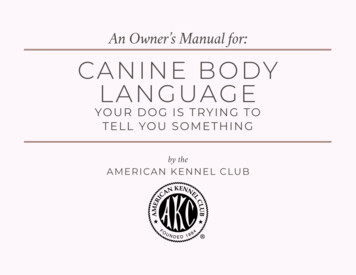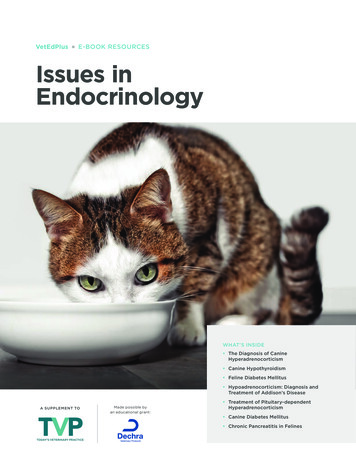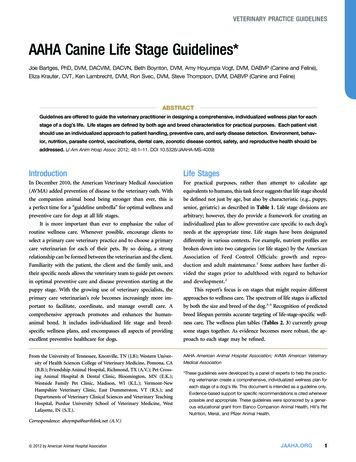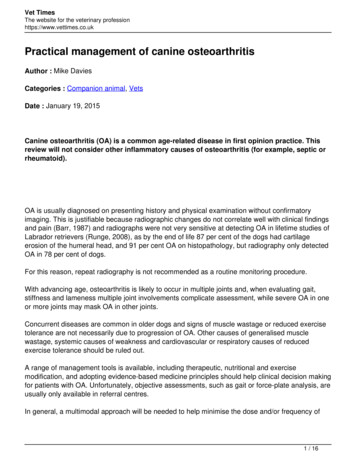
Transcription
Vet TimesThe website for the veterinary professionhttps://www.vettimes.co.ukPractical management of canine osteoarthritisAuthor : Mike DaviesCategories : Companion animal, VetsDate : January 19, 2015Canine osteoarthritis (OA) is a common age-related disease in first opinion practice. Thisreview will not consider other inflammatory causes of osteoarthritis (for example, septic orrheumatoid).OA is usually diagnosed on presenting history and physical examination without confirmatoryimaging. This is justifiable because radiographic changes do not correlate well with clinical findingsand pain (Barr, 1987) and radiographs were not very sensitive at detecting OA in lifetime studies ofLabrador retrievers (Runge, 2008), as by the end of life 87 per cent of the dogs had cartilageerosion of the humeral head, and 91 per cent OA on histopathology, but radiography only detectedOA in 78 per cent of dogs.For this reason, repeat radiography is not recommended as a routine monitoring procedure.With advancing age, osteoarthritis is likely to occur in multiple joints and, when evaluating gait,stiffness and lameness multiple joint involvements complicate assessment, while severe OA in oneor more joints may mask OA in other joints.Concurrent diseases are common in older dogs and signs of muscle wastage or reduced exercisetolerance are not necessarily due to progression of OA. Other causes of generalised musclewastage, systemic causes of weakness and cardiovascular or respiratory causes of reducedexercise tolerance should be ruled out.A range of management tools is available, including therapeutic, nutritional and exercisemodification, and adopting evidence-based medicine principles should help clinical decision makingfor patients with OA. Unfortunately, objective assessments, such as gait or force-plate analysis, areusually only available in referral centres.In general, a multimodal approach will be needed to help minimise the dose and/or frequency of1 / 16
administration of drugs and lifetime management is needed for dogs with OA.OA management for veterinary objectivesCommunication with clientCommunicate clearly with the owner from the outset.Explain how OA is not curable, set realistic expectations for improvement and provide advice aboutfuture management. Explain how the case is likely to progress, what signs to look for, whycompliance with instructions is important and how to monitor progress. Whenever possible, providewritten instructions.Prevention of disease onset or progressionOA is frequently a sequel to trauma, joint laxity (for example, hip dysplasia, patellar luxation orcranial cruciate rupture) or other joint diseases, such as osteochondrosis. Whenever possible, earlyintervention should be performed to mitigate against the development or severity of OA.Surgical removal of intraarticular material and joint stabilisation are two examples of treatments thatmay delay onset or progression.Diets formulated for elderly (senior) dogs usually have a profile considered beneficial in arthritis,including low-calorie content with nutritional supplements (omega-3 fatty acids, glucosamine,chondroitin).In research, hip OA was delayed or prevented in Labrador retrievers fed 25 per cent less food thantheir litter mates and in those that did develop OA the severity was less in the diet-restricted group(Smith, 2006).Healthy dogs should have a body condition score between two and three out of five; however,these studies might not reflect bodyweight alone as diet-restricted dogs consumed 25 per cent lessprotein, carbohydrate, fat, vitamins and minerals, as well as calories.High body mass and body condition score increase biomechanical load bearing on jointscontributing to progression and signs of OA. Obese animals might have other risks for OA becausewhite adipose tissue produces leptin, which induces cartilage degradation by moderating matrixmetalloproteinase activity (Hui, 2012), so obesity should be avoided, or treated if present.There is some laboratory evidence NSAIDs may delay progression of OA, but this has yet to beverified.2 / 16
Relieve painOnce pain is present an analgesic licensed in the UK for use in OA in dogs should be provided(Table 1) and the choice of medicine should be determined after a full assessment and screening ofthe animal for underlying conditions.Concern has been expressed about an increasing off-label use of analgesics, including tramadoland paracetamol, when the efficacy and safety has not been established in dogs (Davies, 2012b;Shaymaa, 2010) and when the evidence is they are not very effective in humans with osteoarthritis(Cepeda, 2006; Towheed, 2006).While we know licensed medicines are effective, it cannot be assumed all individuals are painfree – as some dogs may still be in pain despite treatment (Davies, 2012a) and, therefore, ongoingpain assessment is necessary.Assessment of chronic pain in a brief follow-up consultation can be misleading and other methodsshould be considered, including the use of owner questionnaires (Hielm-Björkman, 2003; WisemanOrr, 2004; Brown, 2007, 2008 and 2009), which can be used to monitor progression long term.I recommend the validated Canine Brief Pain Inventory (CBPI) as reported by Brown, which can bedownloaded for clinical use from the University of Pennsylvania website (www.upenn.edu).Another objective evaluation tool to consider is the use of activity monitors.Medical therapyLicensed NSAIDs are widely used in the management of OA, but they are contraindicated inanimals with cardiac, hepatic or renal disease, or where there is a possibility of gastrointestinalulceration or bleeding, or evidence of blood dyscrasia. According to datasheets, use in elderlyanimals, which are most likely to develop OA, involves an increased risk that requires a reduceddosage and careful clinical management.Care is also needed if an animal is dehydrated, hypovolaemic or hypotensive.Elderly dogs should be screened (history review, physical examination, blood tests and urinalysis)for risk factors for acute renal failure, hepatic disease or gastrointestinal ulceration before NSAIDsare administered. If risk factors are identified, alternative drugs should be used, or a reduced doseand/or increased dosing interval used.The lowest effective dose should be used, but long-term administration is generally better thanshort-term, intermittent administration (Innes, 2010). NSAIDs should not be administered withanother NSAID or corticosteroid; however, in one study (Engelke, 1995) concurrent medication of3 / 16
phenylbutazone with prednisolone in 100 dogs with various musculoskeletal diseases was found tobe effective and no adverse events were noted. Combination products are licensed in the UK (Table 1).There is evidence therapeutic diets can reduce the dose of carprofen and meloxicam withoutcompromising efficacy (Fritsch, 2010; Wernham, 2011).Maintaining limb functionMaintaining limb function and activity is important in preserving quality of life for the dog and itsowner and is achieved by ensuring regular exercise and, when necessary, physiotherapy andhydrotherapy.Articular cartilage obtains nutrients from synovial fluid, and weight-bearing forces and movementare necessary for this to occur. Inactivity leads to muscle wastage, reducing support around jointsand increased joint stiffness. Controlled exercise can be used to build up and strengthen softtissues around joints to help support them.Physiotherapy and hydrotherapy should be carried out by properly trained personnel. A series ofphysiotherapy sessions has been shown to increase the range of movement in arthritic joints indogs (Crook, 2007).Aquatic physical activities – swimming and hydrotherapy – are beneficial by encouraging limbmovement while the dog’s weight is supported in water. Water can also be used to increaseresistance against which the dog has to walk or trot on a submerged treadmill.However, controlled canine studies are needed to determine the true value of these interventions.In humans, significantly less pain and improved physical function, strength, and quality of life werereported, but it was unclear whether the benefits were attributable to intervention effects or aplacebo response (Hinman, 2007).A period of rest is important during acute inflammatory phases and if there is joint effusion, butgenerally, frequent short exercise periods of 15 to 20 minutes are advised. Exercising should notexacerbate clinical signs of pain or reluctance to continue activity. If an inactive dog is required toincrease its exercise this should be introduced gradually.While walking, it is useful for owners to use a GPS system in a mobile phone to measure thedistance and duration of exercise and to keep a diary of events.If their dog starts to tire, or becomes reluctant to walk, the time/distance travelled can be logged tomonitor the animal’s exercise capability.4 / 16
Monitoring exercise through the use of activity monitors is becoming increasingly popular (Brown,2010) especially as they are now relatively cheap. More expensive monitors can be used to obtaina very detailed analysis of exercise patterns.MonitoringIt is important to put in place owner-centric as well as veterinary monitoring for efficacy oftreatment, progression of OA and development of other clinical problems.Basic factors to measure regularly are bodyweight, body condition score and assessments ofmuscle mass. For guidance, see the American Animal Hospital Association guidelines on nutrition(Baldwin, 2010). Also monitor exercise performance – distance and duration – clinical signs and forevidence of other disorders.Nutritional managementVarious nutritional interventions may be considered for the management of canine OA and asummary of the findings of a recent systematic review (Davies, 2014, unpublished) are presentedin Table 2. The highest degree of confidence is for some of the therapeutic diets that have publishedrandomised controlled clinical trials (RCTs) to support their use. I consider the evidence weak ifthere is only one published RCT because in science repeatability is essential to support thefindings as being true. As can be seen from Table 2, when multiple RCTs are available they oftenpresent conflicting evidence.Other treatment modalitiesAcupunctureAlthough widely used in the management of osteoarthritis-associated pain in dogs and humans, thescientific evidence on the efficacy of acupuncture remains controversial. Some studies havesuggested benefits without (Still, 1989) or with gold beads ( Jansenns, 1986; Jaegar 2006;Scognamillo-Szabo, 2010), but others have been unable to demonstrate a beneficial effect,including systematic reviews (Hielm-Bjorkman, 2001; Bolliger, 2002; Habacher, 2006; Sanderson,2009).ElectrotherapyThere are different techniques for applying electrical current to tissues and in one paper (Mlacnik,2006) transcutaneous electrical nerve stimulation (TENS) resulted in improved weight loss andclinical signs.5 / 16
HomeopathyWhile homeopathy is not generally accepted as an effective treatment by the profession, onerandomised, controlled masked trial showed beneficial effects of a homeopathic combinationpreparation called Zeel in the management of canine OA (Hielm-Bjorkman, 2009).Hot and coldWhile the application of cold to inflamed joints to cause vasoconstriction and reduce inflammationis well established in humans, clinical studies are lacking for dogs. Hot packs should not be appliedto swollen joints because vasodilation may make this worse.MassageMassage can help disperse fluid in muscle and, in conjunction with physiotherapy and othermodalities, may help reduce periarticular swellings and stiffness in joints.Regenerative medicineThree studies have reported improvements in lameness, pain and range of movement followingintra-articular administration of autologous adipose-derived mesenchymal stem and regenerativecells in dogs with chronic hip (Black, 2007; Vilar, 2013) and elbow (Black, 2008) osteoarthritis.However, patient numbers were low (n 21 and n 14 respectively) so the studies had weakstatistical power and the latter study was not a randomised, controlled or masked study.SurgeryIn situations in which the patient has severe OA with intractable pain or a non-functional joint orlimb, surgical intervention may be necessary, such as arthrodesis, amputation or joint replacement.However, these may be inappropriate for dogs with multiple joint involvement.UltrasoundTherapeutic ultrasound can be applied in pulsed (non-thermal stimulus) or non-pulsed (thermal andnon-thermal stimuli applied) modes, but is best used in management of muscular conditions ratherthan osteoarthritis.MonitoringDogs with OA should be monitored regularly. The legal requirement for repeat prescriptions ofPOM-V products is six-monthly, but frequency should be tailored to the individual dog and should6 / 16
be more frequent if screening detects evidence of systemic disease.For example, if there is evidence of chronic kidney disease I recommend use of the InternationalRenal Interest Society (IRIS) guidelines (IRIS, 2014) which, depending on staging, can advise reevaluation after two months.Because problems are increasingly likely to arise with advancing age, each re-examination shouldinvolve a detailed history, physical exam and appropriate laboratory evaluations, as well asobjective assessments such as gait analysis, force plate analysis or activity monitors if available.SummaryA step-by-step way to manage OA in dogs:When first diagnosed, identify any underlying cause for the OA and treat if possible to delayprogression.Advise the client of the need for bodyweight control to avoid excessive weight gain andinstitute a weight loss programme for obese dogs.In mild OA consider introducing at least a senior diet, but, preferably, a therapeutic dietformulated for OA that has good controlled clinical studies to support its use.Once pain is present:Obtain a full history, conduct a physical examination and appropriate diagnostic tests to rulein/out clinical or subclinical disease, especially renal or hepatic issues.Use a licensed analgesic. These can be used with confidence for safety and efficacy, butongoing monitoring is still needed, at least every six months (legal requirement), but morefrequently as needed.Avoid off-label use of medicines without proven efficacy and safety.Plan regular reassessments (at least six monthly) based on individual needs.Consider using activity monitors and/or a validated owner questionnaire to assist withongoing assessment of chronic pain.Consider other treatment modalities after discussion with owner, including nutritionalinterventions and alternative treatments, even though the scientific evidence for their usemay be weak.ReferencesBaldwin K, Barges J, Buffington T et al (2010). AAHA nutritional assessment guidelines fordogs and cats, J Am Anim Hosp Assoc 46(4): 285-296.Barr A R S, Denny H R and Gibbs C (1987). Clinical hip dysplasia in growing dogs: the longterm results of conservative management, J Sm Anim Pract 28(4): 243-252.7 / 16
Black L L, Gaynor J, Gahring D et al (2007). Effect of adipose-derived mesenchymal stemand regenerative cells on lameness in dogs with chronic osteoarthritis of the coxofemoraljoints: a randomised, double-blinded, multicentre controlled trial, Vet Ther 8(4): 272-284.Black L L, Gaynor J, Adams C et al (2008). Effect of intra-articular injection of autologousadipose-derived mesenchymal stem and regenerative cells on clinical signs of chronicosteoarthritis of the elbow joint in dogs, Vet Ther 9(3): 192-200.Bolliger C, DeCamp C E, Stajich M, Flo G L, Martinez S A, Bennett R L and Bebchuk T(2002). Gait analysis of dogs with hip dysplasia treated with gold bead implantationacupuncture, Vet Comp Orthop Traum 15(2): 116-122.Brown D C, Boston R, Coyne J and Farrar J T (2007). The Canine Brief Pain Inventory(CBPI): development and psychometric testing of an instrument designed to measurechronic pain in companion dogs with osteoarthritis, Am J Vet Res 68(6): 631-637.Brown D C, Boston R, Coyne J and Farrar J T (2008). Ability of the Canine Brief PainInventory to detect response to treatment in dogs with osteoarthritis, J Am Vet Med Assoc233(8): 1,278-1,283.Brown D C, Boston R, Coyne J and Farrar J T (2009). A novel approach to the use ofanimals in studies of pain: validation of the Canine Brief Pain Inventory in canine bonecancer, Pain Med 10(1): 133-142.Brown D C, Boston R C and Farrar J T (2010). Use of an activity monitor to detect responseto treatment in dogs with osteoarthritis, J Am Vet Med Assoc 237(1): 66-70.Cepeda M S, Camargo F, Zea C and Valencia L (2006). Tramadol for Osteoarthritis.Intervention Review, The Cochrane Collaboration, John Wiley and Sons, doi:10.1002/14651858.CD005522.pub2Crook T I, McGowan C and Pead M (2007). Effect of passive stretching on the range ofmotion of osteoarthritic joints in 10 Labrador retrievers, Vet Rec 160(16): 545-547.Davies M (2012a). Geriatric screening in first opinion practice – results from 45 dogs, J SmAnim Pract 53(9): 507-513.Davies M (2012b). Control of off-label use of medicines, Vet Rec 170(26): 680.Engelke A, Meyer-Lindenberg A, Kietzmann M, Lehmacher W and Nolte I (1995). Efficacyand compatibility of phenylbutazone and prednisolone combination in comparison tophenylbutazone alone in diseases of the locomotor system in the dog, Kleintierpraxis 40:(9)669-679.Fritsch D, Allen T A, Dodd C E et al (2010a). Dose-titration effects of fish oil in osteoarthriticdogs, J Vet Int Med 24(5): 1,020-1,026.Fritsch D, Allen T A, Dodd C E et al (2010b). A multicenter study of the effect of atherapeutic food supplemented with fish oil omega 3-fatty acids on the carprofen dosage indogs with osteoarthritis, J Am Vet Med Assoc 236(5): 535-539.Frantz N, Hahn K, MacLeay J et al (2010). Effect of Prescription Diet canine j/d on clinicalmeasures, cartilage biomarkers, and metabolomic changes in dogs with osteoarthritis, J VetInt Med 24, 718: Abstr 156.Frantz N, Hahn K, MacLeay J et al (2010). Effect of Prescription Diet canine j/d on wholeblood gene expression in dogs with osteoarthritis, J Vet Int Med 24, 771: Abstr 325.8 / 16
Frantz N Z, Hahn K, MacLeay J, Al-Murrani S (2010). Effect of Prescription Diet canine j/don whole blood gene expression in dogs with osteoarthritis, J Vet Int Med 24, 771: Abstr326.Habacher G, Pittler M H and Ernst E (2006). Effectiveness of acupuncture in veterinarymedicine: systematic review, 20(3): 480-488.Hinman R S, Haywood S E and Day A R (2007). Aquatic physical therapy for hip and kneeosteoarthritis: results of a single-blind randomized controlled trial, Phys Ther 87(1): 32-43.Hielm-Björkman A, Raekallio M, Kuusela E et al (2001). Double-blind evaluation of implantsof gold wire at acupuncture points in the dog as a treatment for osteoarthritis induced by hipdysplasia, Vet Rec 149(15): 452-456.Hielm-Björkman A, Kuusela E, Liman A et al (2003). Evaluation of methods for assessmentof pain associated with chronic osteoarthritis in dogs, J Am Vet Med Assoc 222(11):1,552-1,558.Hielm-Björkman A, Tulamo R-M, Salonen H and Raekallio M (2009). Evaluatingcomplementary therapies for canine osteoarthritis – part II: a homeopathic combinationpreparation (Zeel), eCAM 6(4): 465-471.Innes J F, Clayton J and Lascelles B D X (2010). Review of the safety and efficacy of longterm NSAID use in the treatment of canine osteoarthritis, Vet Rec 166(8): 226-230.IRIS (2014). www.iris-kidney.com/guidelinesJaeger G T, Larsen S, Soli N, Moe L (2006). Double-blind, placebo-controlled trial of thepain-relieving effects of the implantation of gold beads into dogs with hip dysplasia. Vet Rec158(21): 722-726.Jansenns L A A (1986). Observations on acupuncture therapy of chronic osteoarthritis indogs: a review of sixty-one cases, J Sm Anim Pract 27(12): 825-837.Mlacnik E, Bockstahler B A, Müller M, Tetrick M A, Nap R C and Zentek J (2006). Effects ofcaloric restriction and a moderate or intense physiotherapy program for treatment oflameness in overweight dogs with osteoarthritis, J Am Vet Med Assoc 229(11):1,756-1,760.Roush K J, Cross A R, Renberg W C et al (2010). Effects of dietary supplementation withfish oil omega-3 fatty acids on weight bearing in dogs with osteoarthritis, J Am Vet MedAssoc 236(1): 67-73.Shaymaa I S, Sherein S A, Elgayed W M et al (2010). Diagnostic studies onacetaminophen toxicosis in dogs, Global Vet 5(2): 72-83.Sanderson R O, Beata C, Flipo R M, Genevois J P, Macias C, Tacke S, Vezzoni A andInnes J F (2009). Systematic review of the management of canine arthritis, Vet Rec164(14): 418-424.Scognamillo-Szabo M V R, Sousa N R, de Tannus L, Carvalho F S R (2010). Acupunctureand gold bead implant for hip dysplasia in German shepherd. [Portuguese], Acta ScientiaeVeterinariae 38(4): 443-448.Smith G K, Lawler D F et al (2006). Lifelong diet restriction and radiographic evidence ofosteoarthritis of the hip joint in dogs, J Am Vet Med Assoc 229(5): 690-693.Still J (1989). Analgesic effects of acupuncture in thoracolumbar disc disease in dogs, J Sm9 / 16
Anim Pract 30(5): 298-301.Towheed T, Maxwell L, Judd M et al (2006). Acetaminophen for osteoarthritis. InterventionReview, The Cochrane Collaboration, John Wiley and Sons. www.updatesoftware.com/pdf/CD004257.pdfVilar J M et al (2013). Controlled, blinded force platform analysis of the effect of intraarticular injection of autologous adipose-derived mesenchymal stem cells associated toPRGF-Endoret in osteoarthritic dogs, BMC Vet Res 9:131.Wernham B G J, Trumpatori B, Hash J, Lipsett J, Davidson G, Wackerow, Thomson P Aand Lascelles B D X (2011). Dose reduction of meloxicam in dogs with osteoarthritisassociated pain and impaired mobility, J Vet Intern Med 25(6): 1,298-1,305.Wiseman-Orr M L, Nolan A M, Reid J and Scott E M (2004). Development of aquestionnaire to measure the effects of chronic pain on health-related quality of life in dogs,Am J Vet Res 65(8): 1,077-1,084.10 / 16
11 / 16
Physiotherapy should be carried out by trained personnel and can increase the range of movementin arthritic joints.IMAGES: Pride Veterinary Centre, Derby.12 / 16
Robert, 13, and Charlie, 10, the author’s elderly Labradors, both have OA. Charlie is a recently13 / 16
rescued dog and has other issues (hence his body condition score).Aquatic physical activity encourages movement while the dog’s weight is supported by the water.Water can also be used to increase resistance using a submerged treadmill.IMAGES: Pride Veterinary Centre, Derby.14 / 16
Table 1. Medicines licensed for use in the management of canine OA in dogs (correct atNovember 24, 2014)15 / 16
Table 2. Summary of grading of the evidence for nutrition in the management of OA in dogsfollowing a systematic review of the literature (Davies, 2014, unpublished)//16 / 16Powered by TCPDF (www.tcpdf.org)
Nutritional management. Various nutritional interventions may be considered for the management of canine OA and a summary of the findings of a recent systematic review (Davies, 2014, unpublished) are presented in . Table 2. The highest degree of confidence is for some of the therapeutic diets that have published
